| L&MR 32 Experiment | |||||||||||||||||
|---|---|---|---|---|---|---|---|---|---|---|---|---|---|---|---|---|---|
 | |||||||||||||||||
| |||||||||||||||||
| |||||||||||||||||
| |||||||||||||||||
Experiment was a steam locomotive designed and built by Richard Roberts in 1833 for the Liverpool and Manchester Railway (L&MR). The locomotive had vertical cylinders driving via bell cranks.
| L&MR 32 Experiment | |||||||||||||||||
|---|---|---|---|---|---|---|---|---|---|---|---|---|---|---|---|---|---|
 | |||||||||||||||||
| |||||||||||||||||
| |||||||||||||||||
| |||||||||||||||||
Experiment was a steam locomotive designed and built by Richard Roberts in 1833 for the Liverpool and Manchester Railway (L&MR). The locomotive had vertical cylinders driving via bell cranks.
L&MR No.32 [1] Experiment was built in 1833 with vertical cylinders mounted just behind the chimney, driving the wheels via a bell crank. The locomotive also had piston valves. These valves were probably the reason that the design was not a success, rather than the bell crank transmission, which was used successfully in other locomotives. [2] Another reason that the locomotive was not successful was steam leakage from the cylinders. [1] Experiment was withdrawn after a few months. [2]
Three similar locomotives were built for the Dublin and Kingstown Railway. [1] Locomotives to this design were built for the Dundee and Newtyle Railway, but they were soon altered. [2]
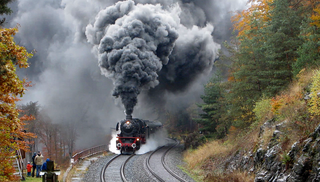
A steam locomotive is a type of railway locomotive that produces its pulling power through a steam engine. These locomotives are fuelled by burning combustible material—usually coal, wood, or oil—to produce steam in a boiler. The steam moves reciprocating pistons which are mechanically connected to the locomotive's main wheels (drivers). Both fuel and water supplies are carried with the locomotive, either on the locomotive itself or in wagons (tenders) pulled behind.
A geared steam locomotive is a type of steam locomotive which uses gearing, usually reduction gearing, in the drivetrain, as opposed to the common directly driven design.

The locomotive Saxonia was operated by the Leipzig–Dresden Railway Company and was the first practical working steam locomotive built in Germany. Its name means Saxony in Latin.
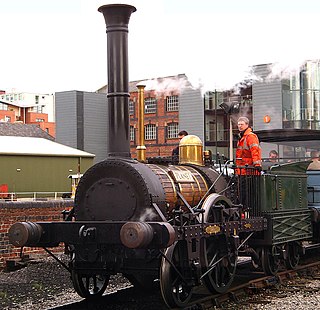
Under Whyte notation for the classification of steam locomotives, 2-2-0 represents the wheel arrangement of two leading wheels on one axle, two powered driving wheels on one axle, and no trailing wheels. This configuration, which became very popular during the 1830s, was commonly called the Planet type after the first locomotive, Robert Stephenson's Planet of 1830.

The GWR 4100 Class was a class of steam locomotives in the Great Western Railway (GWR) of the United Kingdom.
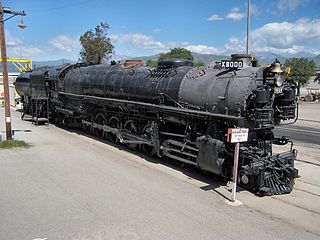
Under the Whyte notation for the classification of steam locomotives, 4-12-2 represents the wheel arrangement of four leading wheels, twelve coupled driving wheels, and two trailing wheels. This arrangement was named the Union Pacific type, after the only railroad to use it, the Union Pacific Railroad.

Novelty was an early steam locomotive built by John Ericsson and John Braithwaite to take part in the Rainhill Trials in 1829.

The Stephenson valve gear or Stephenson link or shifting link is a simple design of valve gear that was widely used throughout the world for all kinds of steam engines. It is named after Robert Stephenson but was invented by his employees.

Sharp, Stewart and Company was a steam locomotive manufacturer, initially based in Manchester, England. The company was formed in 1843 upon the demise of Sharp, Roberts & Co.. It moved to Glasgow, Scotland, in 1888, eventually amalgamating with two other Glasgow-based locomotive manufacturers to form the North British Locomotive Company.

The cylinder is the power-producing element of the steam engine powering a steam locomotive. The cylinder is made pressure-tight with end covers and a piston; a valve distributes the steam to the ends of the cylinder. Cylinders were cast in iron and later made of steel. The cylinder casting includes other features such as valve ports and mounting feet. The last big American locomotives incorporated the cylinders as part of huge one-piece steel castings that were the main frame of the locomotive. Renewable wearing surfaces were needed inside the cylinders and provided by cast-iron bushings.
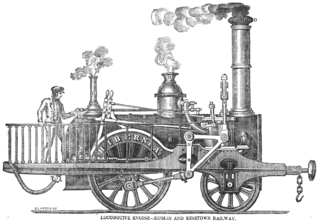
Hibernia was a steam locomotive designed by Richard Roberts and built by Sharp, Roberts and Company in 1834 for the Dublin and Kingstown Railway (D&KR). The locomotive had vertical cylinders driving via bell cranks.
A compound locomotive is a steam locomotive which is powered by a compound engine, a type of steam engine where steam is expanded in two or more stages. The locomotive was only one application of compounding. Two and three stages were used in ships, for example.
The South African Railways Class 16A 4-6-2 of 1915 was a steam locomotive.
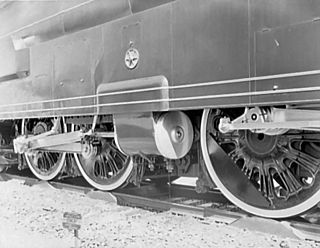
A duplex locomotive is a steam locomotive that divides the driving force on its wheels by using two pairs of cylinders rigidly mounted to a single locomotive frame; it is not an articulated locomotive. The concept was first used in France in 1863, but was particularly developed in the early 1930s by the Baldwin Locomotive Works, the largest commercial builder of steam locomotives in North America, under the supervision of its then chief engineer, Ralph P. Johnson.

The South African Railways Class 6L 4-6-0 of 1904 was a steam locomotive from the pre-Union era in the Cape of Good Hope.

The LNWR Dreadnought class was a class of 40 passenger three-cylinder compound 2-2-2-0 locomotives designed by F. W. Webb for the London and North Western Railway, and manufactured by them in their Crewe Works between 1884 and 1888. The railway also commissioned the Beyer, Peacock and Company to construct an additional locomotive of the design for the Pennsylvania Railroad.

The LNWR Teutonic class was a class of 10 passenger three-cylinder compound 2-2-2-0 locomotives designed by F. W. Webb for the London and North Western Railway, and manufactured by them in their Crewe Works between 1889 and 1890.
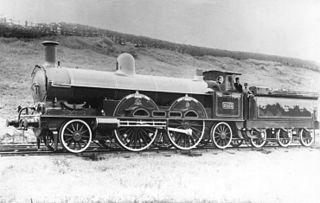
The London and North Western Railway (LNWR) Greater Britain class was a class of ten 2-2-2-2 steam locomotives designed for express passenger work by F. W. Webb.
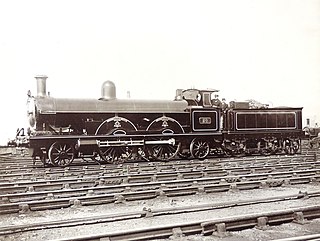
The London and North Western Railway (LNWR) John Hick class was a class of ten 2-2-2-2 steam locomotives designed for express passenger work by F. W. Webb.

Swiftsure was first of eight or more similar locomotives with a single pair of driving wheels built by George Forrester and Company (Forresters) from 1834. The tank variant was the first passenger tank engine to enter service in the world.